Business Ventilation Fund: evaluation
Assesses the outputs and indicative outcomes of the Business Ventilation Fund with the aim of improving ventilation in business premises and reducing the risk of COVID-19 transmission.
Evaluation Results
Outputs
Summary
- The BVF received 1,363 applications, of which 577 were accepted (42%), 250 were rejected (18%), 514 were closed and 22 were withdrawn (39% were closed or withdrawn).
- In total £981,130 was paid to recipients of the BVF. This was significantly lower than the total budget set aside for the fund (£25 million). Initial budget allocations for demand-led grant schemes such as this are not always paid out in full. Grants were paid to those businesses who met the fund criteria, however not all eligible businesses applied.
- A total of 1,647 ventilation items were purchased by businesses under the BVF scheme, with the most commonly purchased items being air filters/purifiers (20% of items), small mechanical vents/extractor fans (13%) and standalone CO2 monitors (12%)
- The cities of Glasgow and Edinburgh together accounted for over a quarter of applications, acceptances and the amount paid.
- Acceptance rates varied significantly between local authorities which may indicate inconsistencies in the approach to assessing applications across local authorities.
- Micro businesses (0-9 employees) accounted for over half of applications, acceptances and amount paid.
- By premise type, close contact services such as hairdressing and beauty services accounted for the greatest proportion (over a fifth) of applications, awards and amount paid, followed by hospitality premises.
- Whilst the expansion of the fund criteria to include business premises classed as medium and low risk settings (for people coming into close contact) did help these sectors to benefit from funding, the funding was overwhelming concentrated on high risk sectors, which accounted for almost 80% of applications, awards and the amount paid.
This section provides an overview of the management information data on applications, acceptances, amount paid and ventilation items purchased. Breakdowns by local authority, premise type and business size are provided. While the scheme management information did not collect data on the protected equalities characteristics such as the gender, age and ethnicity of the business owners applying to the fund, this information was collected as part of the business survey and is presented below to supplement the management information data. The source data for all graphs and visualisations in this report is from Coronavirus (COVID-19): Business Ventilation Fund experimental statistics, unless otherwise specified.
Applications, Acceptances and Amount Paid
In total, the fund received 1,363 applications, of which 577 were accepted (42%), 250 were rejected (18%), 514 were closed[5] and 22 were withdrawn (39% were closed or withdrawn).
The most common reasons for rejection were 'failed business checks' (27%), 'not in an eligible sector as declared' (26%), and 'invalid/incomplete non-domestic rate number' (23%). Of the 22 applications that were withdrawn, the most common reasons were 'duplicate application' (59%) and 'no longer required' (41%). Local Authorities received 30 requests from businesses for their application decision to be reviewed, of which 25 decisions were revised (83%) and 5 were upheld (16%).
In total £981,130 was paid to recipients of the BVF, with an average (mean) award amount of £1,700.
The total amount paid was significantly lower than the total budget set aside for the fund (£25 million). Initial budget allocations for demand-led grant schemes such as this are not always paid out in full and each fund has criteria that requires to be met to ensure best value for public money. Grants were paid to those businesses who met the fund criteria, however not all eligible businesses applied. It is likely the disruptions due to the Omicron variant would have significantly impacted businesses' ability to improve their ventilation and claim these costs back.
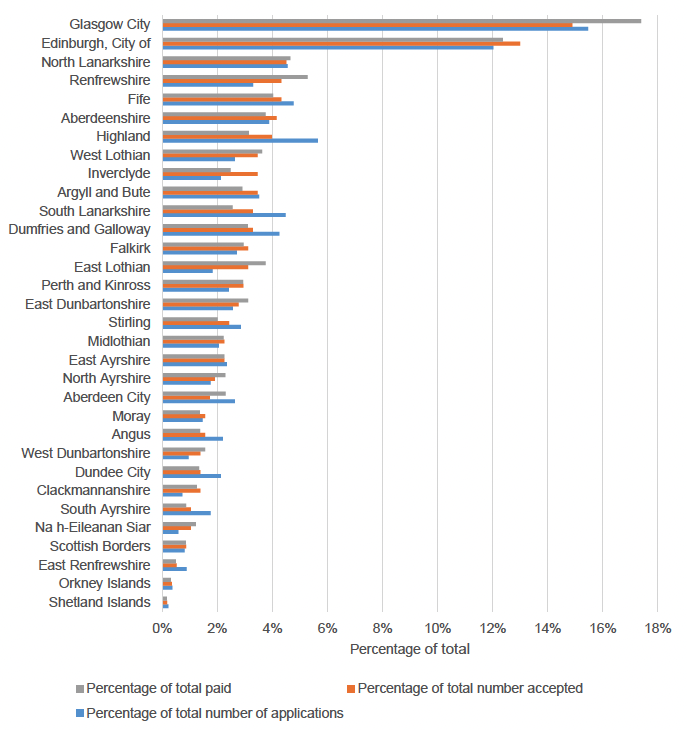
Local authority
Looking at the breakdown by local authority, the cities of Glasgow and Edinburgh together accounted for over a quarter of applications, acceptances and the amount paid (Figure 1).
Acceptance rates (number of acceptances as a proportion of number of applications) varied significantly between local authorities from 25% in South Ayrshire (24 applications) to 80% in Clackmannanshire (10 applications) (Figure 2). The high variation in acceptance rates may be due in part to the relatively low numbers of applications numbers in some local authorities however it may also indicate inconsistencies in the approach to processing and assessing applications across local authorities.
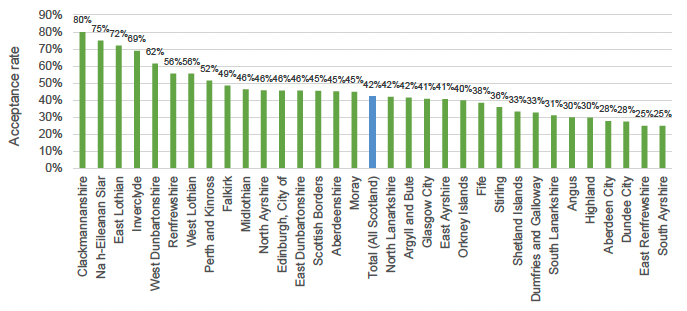
Business size band
By business size band, micro businesses (0-9 employees) accounted for over half of applications, acceptances and amount paid (Figure 3).
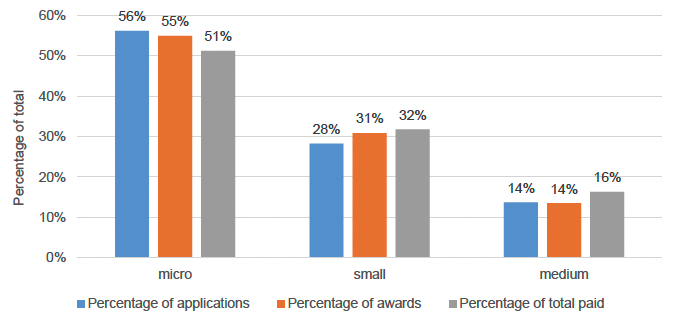
Premise type
By premise type, close contact services such as hairdressing and beauty services and massage therapies accounted for the greatest proportion (over a fifth) of applications, awards and amount paid, followed by hospitality premises (cafes, restaurants, public houses and takeaways - shown separately in Figure 4) and pharmacies (Figure 4).
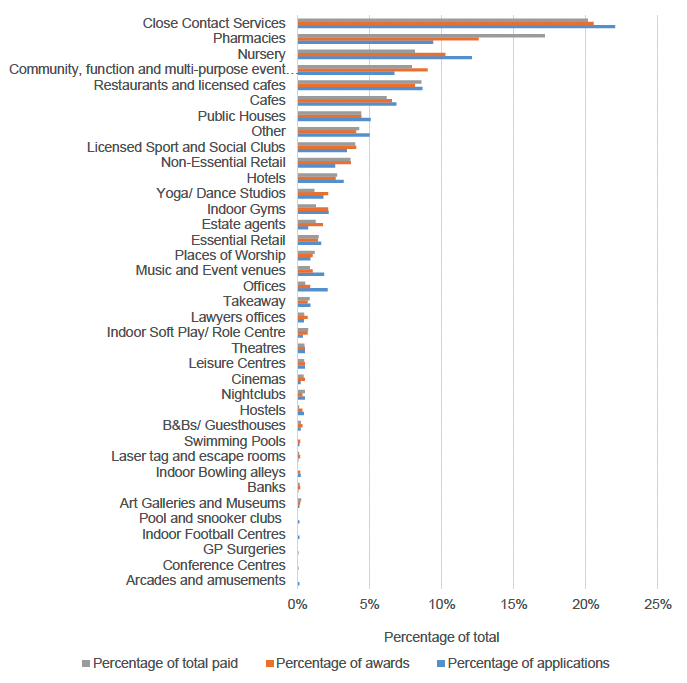
The sectors above can be classified into different risk categories (low, medium and high risk settings) in terms of the risk these settings pose for people coming into very close contact. The fund was initially aimed only at businesses operating in high risk settings however, the eligibility criteria was later extended to include medium and low-risk settings. High risk sectors accounted for 75% of applications, 77% of awards and 77% of the amount paid. Medium and low risk sectors, which became eligible for the fund at a later stage, accounted for around 23% of applications, 22% awards and 18% of total amount paid (Figure 5)[6]. This indicates that whilst the expansion of the fund criteria did help medium and low risk sectors to benefit from funding, the funding was overwhelming concentrated on high risk sectors.
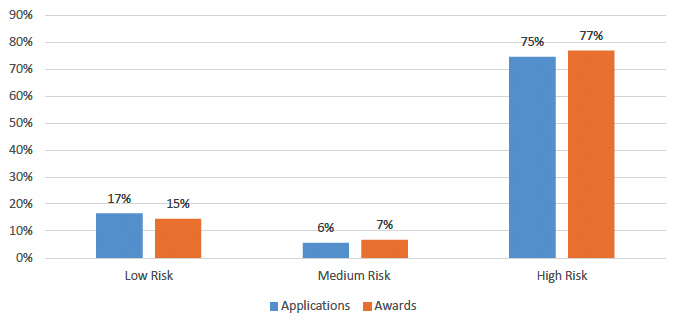
Business age
Awards were made to businesses across multiple age categories. Over half of awards were made to businesses that had been operating for over 11 years (54%) and 42% were made to businesses operating from 1 to 10 years. Only 4% were made to new businesses that had been in operation for less than a year.
Business type
The majority of awards were made to limited companies (68%) and sole traders (13%). Businesses could be classified as a sole trader according to business size, but also operate as another business type e.g. a limited company.
Protected Equalities Characteristics
Information on protected equality characteristics such as the gender, age and ethnicity of the business owners was not collected as part of the scheme management information. This information was however collected from those businesses who completed the survey. This survey data can therefore be used to supplement the management information data to provide an indication of the likely equalities characteristics of those businesses that engaged with the fund. (Note that responses are for all those surveyed, not just successful applicants.)
- Gender:Of those businesses surveyed, 44% said that their business was woman-led. 31% said their business was equally led by men and women, and 16% said that their business was not woman-led[7].
- Ethnicity:Of those surveyed, 67% responded that their business leader was 'White Scottish', 14% were 'White - Other British,' and 5% 'White – Other'. 3% of survey respondents said their business leader was 'Mixed White and Asian', 1% 'Pakistani', 1% 'Bangladeshi', 1% 'Any other Asian Background' and 1% 'Other'[8] .
- Age: Of those surveyed, the most common age groups for business leaders were 40-49 and 50-59 (both 27%). Business leaders under 30 or over 70 were a small minority at 3% and 2% respectively.
Ventilation Items Purchased
A total of 1,647 ventilation items were purchased by businesses under the BVF scheme[9]. The most common items purchased were air filters/purifiers (20% of items), small mechanical vents/extractor fans (13%) and standalone CO2 monitors (12%) (Figure 6).
| Ventilation Item purchased |
Total number of items |
Percentage of items |
|---|---|---|
| Air filters/purifiers |
328 |
20% |
| Small mechanical vent/extractor fan |
214 |
13% |
| Standalone CO2 monitor (single spaces) |
197 |
12% |
| Unblocking windows/small repairs/enhancements |
148 |
9% |
| Window servicing |
115 |
7% |
| Monitoring equipment |
112 |
7% |
| Networked CO2 monitors (multiple spaces) |
101 |
6% |
| Installation costs |
89 |
5% |
| Additional sensors for networked CO2 monitors |
80 |
5% |
| Gateway system for networked CO2 monitors |
79 |
5% |
| Vents |
62 |
4% |
| Undercutting/raising non-fire doors |
43 |
3% |
| Airbricks |
27 |
2% |
| Networked CO2 monitors (mechanically ventilated spaces) |
23 |
1% |
| Window contact sensors |
20 |
1% |
| Automatic openers for ceiling windows |
9 |
1% |
Impacts
Summary
- The vast majority (93%) of successful claimants surveyed said that the ventilation improvements made with BVF funding had 'some' or a 'strong' impact' on ventilation within their premises.
- The fund appears to have been integral to businesses improving their ventilation, with two thirds of surveyed businesses who had successfully made a claim stating that they would be quite or highly unlikely to have made improvements without the funding. This indicates that the fund had an 'additional' impact on business ventilation improvements.
- Almost two thirds (63%) of successful claimants believed that the funding amount was sufficient to make a positive improvement to their premises' ventilation.
- The BVF appears to have a positive impact on businesses' awareness of the importance of ventilation in closed spaces to guard against the spread of COVID-19, with almost half of businesses surveyed saying the fund had significantly or hugely increased their awareness.
- The fund also appears to have had a positive impact on the proportion of businesses monitoring the air quality of their premises, with the proportion of successful claimants surveyed measuring air quality increasing from 11% before the BVF to 50% after.
- The BVF appears to have addressed a key business need for applicants, with the majority of survey respondents stating that improving ventilation was a priority for their businesses and almost three quarters (74%) of successful claimants stating that the fund completely or significantly met their business needs.
- The BVF seems to have had a positive impact on consumer confidence in the safety of business premises who received funding. Of those respondents who received an award, 64% felt it has hugely or significantly increased consumer confidence in the safety of their business premises.
Whereas the previous section focussed on the outputs of the fund in terms of numbers of businesses supported and ventilation items purchased based on the scheme management information data, this section draws on the business survey data to consider the impact the fund had on businesses.
Impact on ventilation
As shown below in Figure 7, the vast majority of successful claimants surveyed (93%) said that the ventilation improvements made from BVF funding had 'some' or a 'strong' impact' on ventilation within their premises. A small minority of respondents said that there was little (5%) or no impact (1%.)
The fund appears to have been integral to businesses improving their ventilation. Surveyed businesses who had successfully made a claim were asked how likely they would you have been to make improvements to ventilation without the funding. Two thirds (66%) said they would be quite or highly unlikely to have made improvements without the funding. This indicates that the fund had an 'additional' impact on business ventilation improvements.
All surveyed businesses were also asked if they had made any ventilation improvements in the last three years. The majority (81%) said they had not, again indicating that the fund is likely to have been key to businesses taking measures to improving their ventilation.
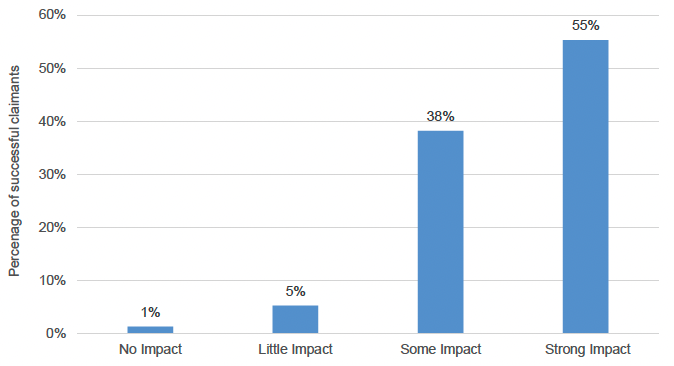
Base: All successful claimants: 76. Base minimum: 'no impact': 1.
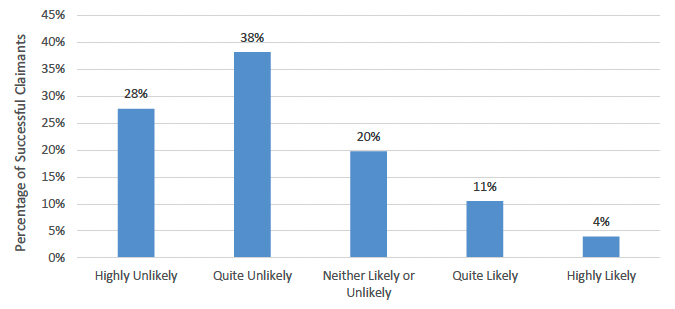
Base: All successful claimants: 76. Base minimum: 'highly likely': 3.
Businesses that had successfully made a claim were asked whether the total amount of funding available (£2,500) was sufficient to make a positive impact on ventilation. Almost two thirds (63%) of successful claimants believed that the funding was sufficient while around a fifth (22%) felt it was insufficient (Figure 9).
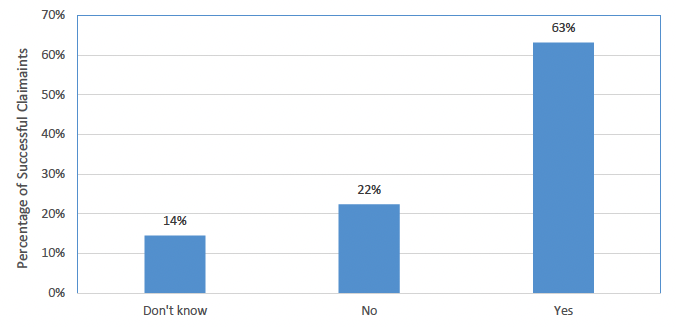
Base: Successful Claimants: 76. Base minimum: 'don't know': 11.
Impact on awareness of importance of and monitoring of ventilation
The BVF appears to have a positive impact on businesses' awareness of the importance of ventilation. All businesses surveyed were asked the extent the BVF had increased their awareness of the importance of ventilation in closed spaces to guard against the spread of COVID-19. Almost half of businesses surveyed said the BVF had either 'significantly increased' or 'hugely increased' their
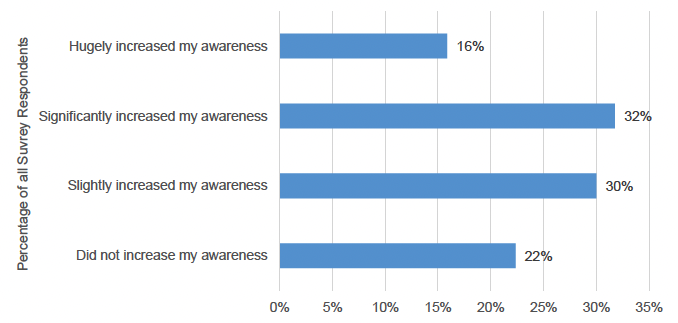
Base: All surveyed: 172 (2 Not Answered). Base minimum: 'Hugely Increased My Awareness' 27
awareness of the importance of ventilation. However just over a fifth (22%) said that it did not increase their awareness (Figure 10).
The fund also appears to have had a positive impact on the proportion of businesses monitoring the air quality of their premises. Businesses that had successfully made a claim were asked whether air quality was measured on their premises, before and after their interaction with the fund. The survey results show a large swing towards businesses measuring air quality after accessing the fund. Prior to the BVF, only 11% of claimants measured air quality however this rose to 50% after accessing the fund (Figure 11).
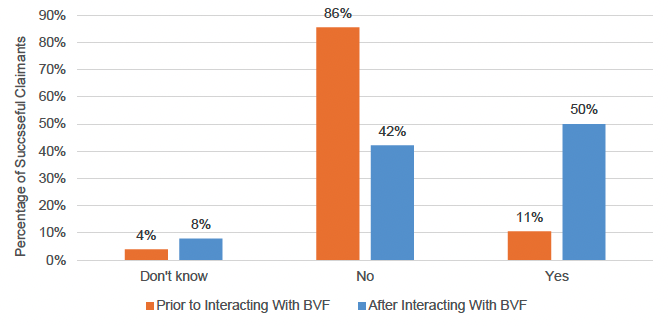
Base: Successful Claimants: 76 Base minimum: 'Don't Know': 3/6.
Extent to which the fund met business needs
The BVF appears to have addressed a key business need. All businesses surveyed were asked to what extent improving ventilation was a priority for businesses when they first applied for the BVF. The majority (97%) said it was a priority ('slight priority', 'somewhat priority' or 'high priority'), with 58% saying it was a 'high priority'. Only 3% stated it was not a priority. This is perhaps unsurprising given the nature of COVID-19 restrictions at the time and suggests that the fund addressed a key priority for businesses.
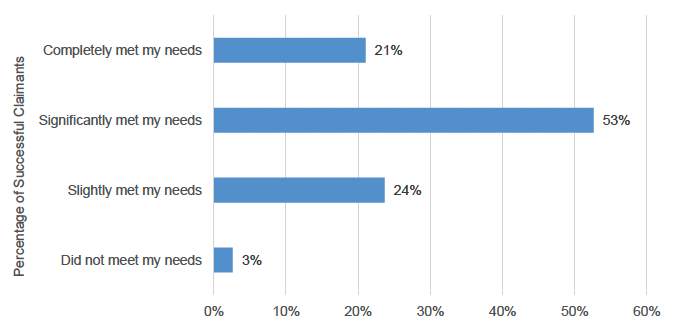
Base: All successful claimants: 76. Base minimum: 'did not meet my needs': 2.
Successful claimants were asked to what extent the BVF met the needs of their business. Almost three quarters (74%) said it completely or significantly met their business needs. Only 3% (2 respondents) said that the BVF did not meet their needs (Figure 12).
Impact on consumer confidence
The BVF seems to have had a positive impact on consumer confidence in the safety of business premises who received funding. Of those respondents who received an award (76 businesses), 64% felt it has 'hugely' or 'significantly' increased consumer confidence in the safety of their business premises. 24% felt it slightly increased consumer confidence while 12% stated that the BVF did not increase confidence (Figure 13).
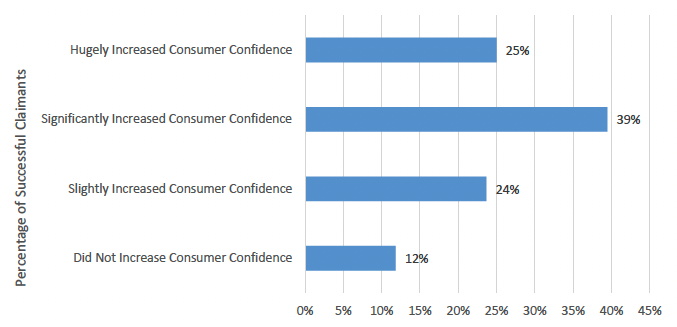
Base: Successful Claimants: 76; base minimum: 'did not increase customer confidence': 9
Process
Summary
- The majority (83%) of fund payments were made within the target four week window.
- Business perceptions on the ease of the application and claims processes were mixed. Around a third of businesses surveyed found the application process 'very easy' or 'easy' while 41% felt it was 'very difficult' or 'difficult'. Roughly the same proportion of respondents who proceeded to the claims stage in their application found it 'very easy' or 'easy' (40%) as those that felt it was 'difficult' of 'very difficult' (36%).
- A significant proportion of businesses appear to have encountered issues with the application and claims processes. Almost two thirds of businesses surveyed (61%) stated that they had issues with the application process while just over half (53%) said they had an issue with the claims process.
- Feedback on the clarity of the BVF guidance was mixed with roughly the same proportion of businesses reporting that they found it unclear (41%), as those that found it clear (46%).
- Most businesses (73%) found the self-assessment tool useful to some extent.
- Most surveyed businesses had heard about the BVF via the Scottish Government website (37%), Business Groups/Organisations (18%) or the 'Find Business Support' website (12%).
- Over two thirds of businesses surveyed (69%) said they would be quite or highly likely to apply for future funding related to ventilation improvements.
- Business suggestions to improve similar business funding in the future included improving communication with applicants, reducing criteria restrictions to applications and providing funding in advance of businesses incurring the costs rather than on a reimbursement basis.
Whereas the previous section considered the outputs and emerging impacts of the fund, this section draws on the management information and survey data on business perceptions of their engagement with the fund to understand the extent to which the application, claims and payment processes of the fund were executed successfully.
Payment process
The management information data shows that approximately 83% of payments were made within the target four weeks from when the completed application and supporting documentation were received, with an average of about two and a half weeks from documentation receipt to payment.
Application and claims process
Businesses' perceptions on the ease of the application process were mixed. Around a third of businesses surveyed found the process 'very easy' or 'easy' while 41% felt it was 'very difficult' or 'difficult'. A quarter felt it was 'neither easy or difficult' (Figure 14).
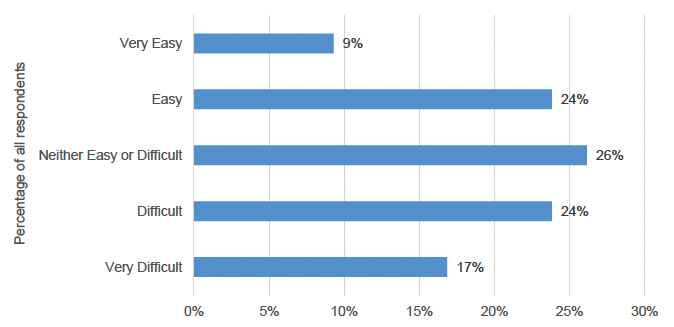
Base: All respondents (172) Base minimum: 'Very Easy': 16
As with the application process, businesses' perceptions on the ease of the claims process were mixed with roughly the same proportion of respondents who proceeded to the claims stage in their application finding it 'very easy' or 'easy' (40%) as those that felt it was 'difficult' of 'very difficult' (36%) (Figure 15).
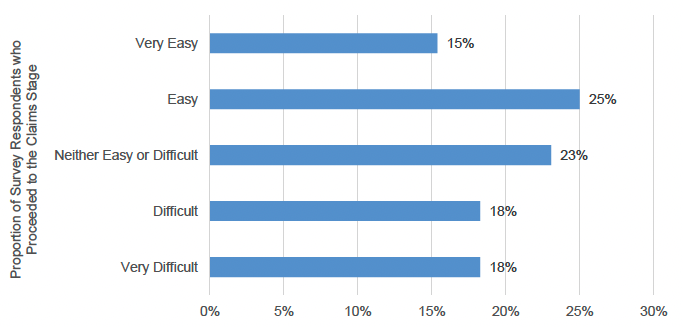
Base: Surveyed businesses who proceeded to the claims stage (104) Base minimum: 'Very Easy': 16
A significant proportion of businesses appear to have encountered issues with the application and claims processes. As shown in figure 16 below, almost two thirds of businesses surveyed (61%) stated that they had issues with the application process. Just over half (53%) said they had an issue with the claims process.
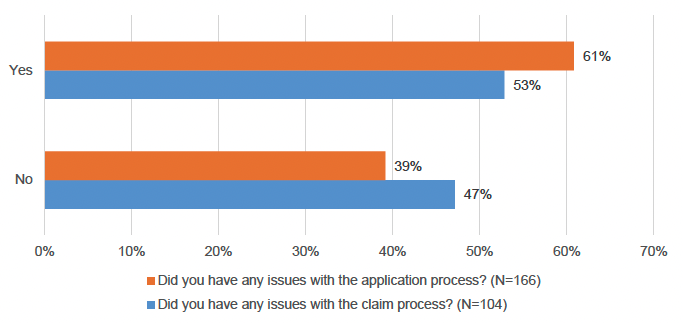
Base: All respondents (166, 6 did not answer); respondents who submitted a claim (104); base minimum: 'No': 50/65
Businesses were asked what issues they experienced with the BVF application process. The most commonly reported issue was 'other' (25%), followed by 'no support available' (22%) and 'questions not clear / difficult to understand' (18%) (Figure 17). While the issues noted within the 'other' category varied, key themes that emerged include: unclear or infrequent communication with staff regarding the fund; items were too expensive to purchase and then claim through the fund; difficulty in sending evidence/documents; and tight deadlines.
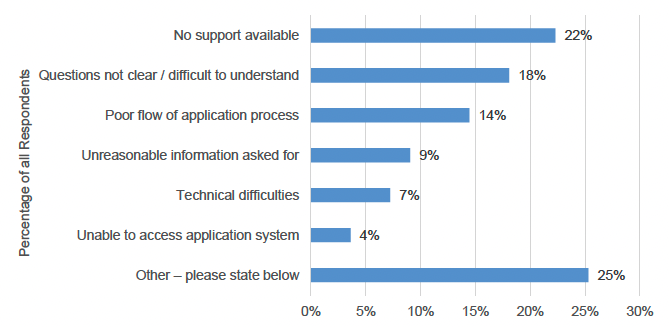
Base: All respondents (166, 6 did not answer) Base minimum: 'Unable to access application system': 6
The most commonly reported issue with the claims process was that businesses 'couldn't complete the work in the required timescales' (25%), followed by 'other' (21%) and 'not enough guidance was available' (17%) (Figure 18). While the issues noted within the 'other' category varied, key themes that emerged included: difficulties in gathering information required; tight timescales for completing applications; tight timescales for completing upgrades and installations (also difficulties in finding available tradesmen at short notice); and lack of communication with the fund.
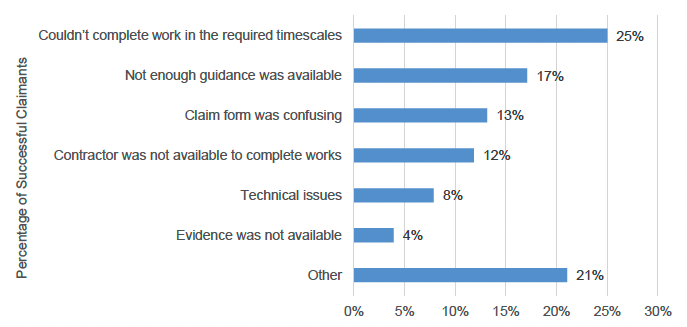
Base: Respondents who made a successful claim (76) Base minimum: 'Evidence Was Not Available': 3
Guidance
Feedback on the clarity of the BVF guidance was mixed with roughly the same proportion of businesses reporting that they found it very unclear or unclear (41%), as those that found it clear or very clear (46%) (Figure 19).
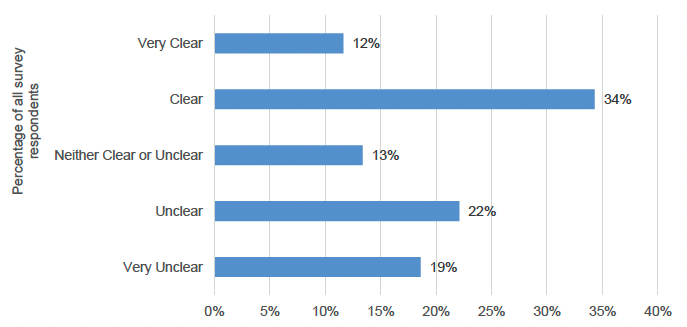
Base: All respondents: 172; base minimum: 'Very Clear': 20
Around two thirds of respondents (65%) felt that further guidance on the improvements available under the fund would have been useful (figure 20).
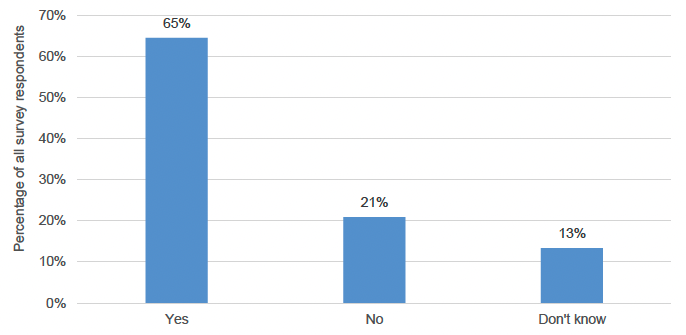
Base: All respondents: 170 (2 Not Answered); base minimum: 'Don't Know': 23
Source: Coronavirus (COVID-19): Business Ventilation Fund Evaluation Business Survey
Feedback from surveyed businesses on the BVF self-assessment tool suggested that most businesses (73%) found it useful to some extent ('slightly useful', 'quite useful' or 'very useful'). However, around a third (27%) felt it was not useful (Figure 21).
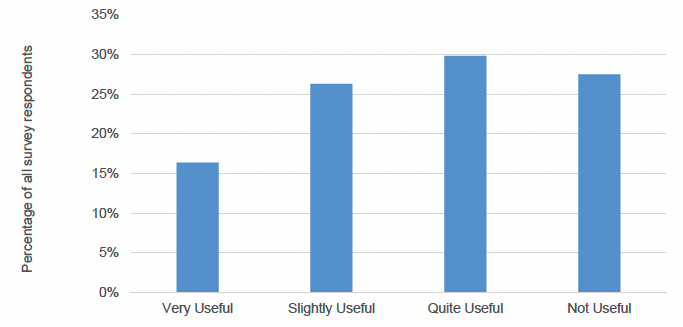
Base: All respondents: 171 (1 Not Answered); base minimum: 'Very Useful': 28
Communication
Survey respondents were asked how they heard about the BVF. The most common response was the Scottish Government website (37%) followed by Business Groups/Organisations (18%) and the 'Find Business Support' website (12%) (Figure 22).
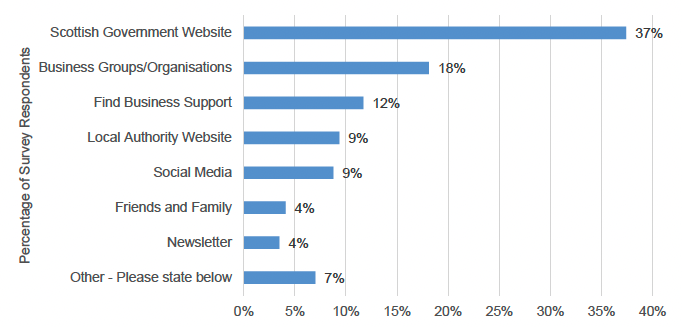
Base: All respondents: 171 (1 Not Answered); base minimum: 'Newsletter': 6
Future support
All businesses surveyed were asked how likely they would be to apply for future funding related to ventilation improvements. Over two thirds of businesses (70%) said they would be quite or highly likely to apply. 18% said that would be highly unlikely (Figure 23).
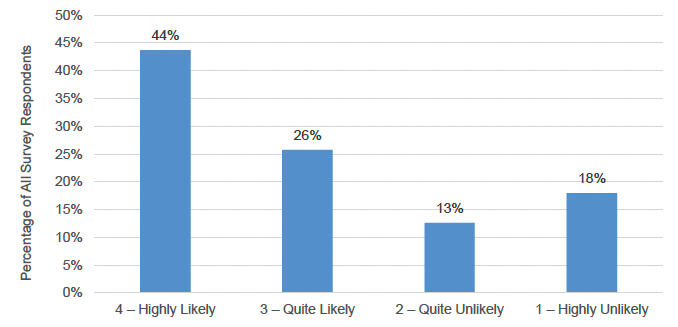
Base: All respondents: 167 (5 Not Answered) Base minimum: 'Highly Unlikely': 29 total
Respondents were asked what changes they thought could be made to future business funding aimed at improving ventilation. While respondents provided a wide variety of suggestions, the responses fell broadly into three main themes:
- Improve replies and reply timescales to applicant businesses, and general communication.
- Reduce restrictions to applications such as business type, resulting in fewer rejected applications.
- Reconsider the payment and reimbursement mechanism in place, which necessitated premises to pay for the improvements and then reclaim their costs, which caused hesitation for some applicants.
Contact
Email: ceu@gov.scot
There is a problem
Thanks for your feedback